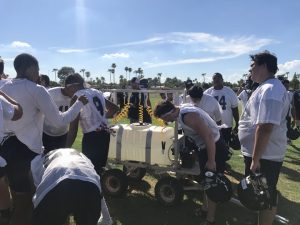- Slug: Sports-AIA health initiative, 530 words
- Photo available
By FAITH PHARES
Cronkite News
TEMPE — As high schools reopen across the state, sports take center stage. They offer rewards but also risks for athletes practicing and competing in extreme temperatures.
The most common causes of death among high school athletes are heat illness, cardiac arrest and head injury, according to the Arizona Interscholastic Association, which launched an initiative to address these issues.
“Head, Heart and Heat” is designed to help coaches and administrator prepare for situations that call for medical attention.
Kareem Shaarawy, a sports medicine physician at Barrow Neurological Institute, spoke at a recent Tempe McClintock High School football practice, where it was 110 degrees. He highlighted the program’s goals and intended impact, and provided tips for athletes to acclimate to outdoor summer workouts.
“The bottom line is coaches need to be aware. … They need to educate their kids. They need to educate their parents,” Shaarawy said. “Coaches, it’s our responsibility to keep the kids safe.”
The program’s goal is to advise coaches, administrators and players on prevention and management.
“(Education) has been key in reducing or limiting that risk with heat illness,” Shaarawy said.
After having the summer off, which is mandated by the AIA’s rules and regulations, McClintock’s football program has returned to practice as it prepares for 2017. After a disappointing season, success is the focus in practice. The team, however, has taken time to learn basic precautions when practicing in the heat.
Even the toughest kids will display physical signs of pain when injured, McClintock coach Corbin Smith said. These signs are key for monitoring an athlete’s health.
“You just need to check on them,” he said. “As far as the concussions and being aware of that, you can look into a kid’s eye and know, and it there is any doubt, it’s our responsibility to get them over to the trainer.”
The team trainer plays a crucial role in helping prevent these injuries, Shaarawy said.
“I think they are a physician extender and they help support us and they help protect these student-athletes,” he said. “And (they are) working well with the coaches and making sure that the athletes are as healthy as possible.”
The National Federation of State High School Associations conceived the program. Experts from the Barrow Neurological Institute advised the AIA on the Head, Heat and Heat program in Arizona.
Although the program has not been established for long, Shaarawy believes it could be a key in preventing deaths in the future.
